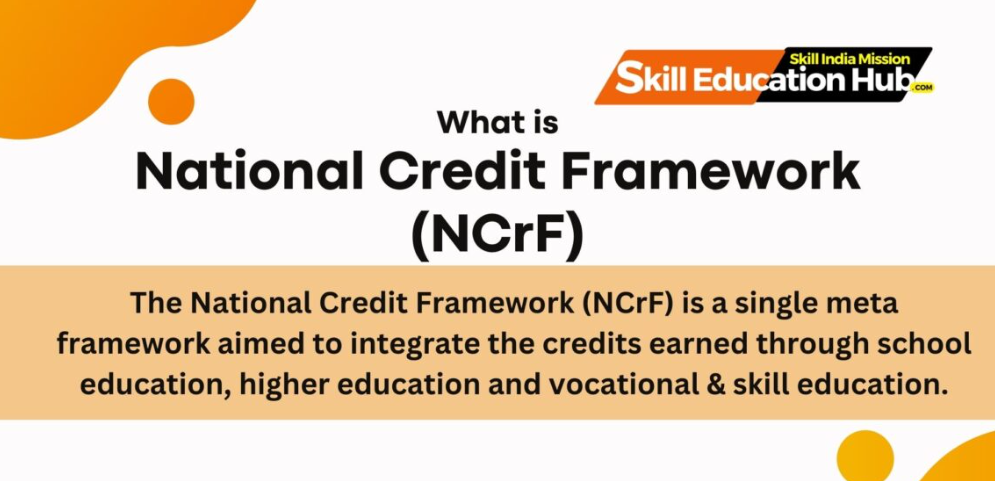National Credit Framework (NCrf)
Syllabus:
GS 2: Education
Why in the News?
National Credit Framework (NCrF) introduced to facilitate reforms in higher education, which balances vocational training with academic research to meet the evolving socio-economic needs of India.
Introduction
- The National Credit Framework (NCrF), in line with NEP 2020, provides a transformational platform for Indian higher education by integrating academic skills with vocational skills training.
- NCrf encourages flexibility and multidisciplinary learning, preparing students for employment developing markets and fostering personal and social development.
National Credit Framework (NCrF)
- Inclusive Policy: NCrF integrates school, higher education, and vocational education into one credit program.
- Credit Assignment: 40 credits are awarded for 1200 hours of learning per year, each credit equal to 30 hours.
- Flexibility: NCRF allows for mobility between vocational degrees, enabling multiple entry options and loan accumulation across different courses.
Scrutiny
- Competency-Based Education: Credit is based on academic achievement and includes both academic and experiential/industrial learning.
- Academic Bank of Credits (ABC): It stores and redeems credits digitally, ensuring portability and easy verification.
National Education Policy (NEP) 2020
- NEP 2020 aims to transform education in India, moving away from the colonial mindset.
- It is a vision document that focuses on transforming schools, higher education, vocational and skills education.
National Credit Framework (NCrF)
- NCRF is derived from NEP 2020 as a flexible framework for educational institutions.
- It allows credit to be pooled and transferred for a variety of disciplines, including competency-based education.
- Higher education institutions (HEIs) can use this framework to integrate interdisciplinary learning.
- The NCRF acts as an enabler, not a regulatory framework, that advances educational reform.
NCrf: Transforming Education in India
Flexible Approach
- National Credit Program (NCrF) allows students to earn degrees in a variety of programs, provided they are tested.
- Credit can be earned for classroom teaching, lab work, tinkering labs, research projects, and activities.
- Credit framework includes Activities like sports, yoga, acting, music, handicrafts, social work, National Service Scheme (NSS).
- Diversity: Students can earn credits in internships, apprenticeships, on-the-job training, experiential learning, and vocational education.
- Flexibility and Variability offered by the NCRF provides a broad, interdisciplinary approach to higher education.
Challenges
- Flexibility in the NCrF is viewed with skepticism by a number of individuals rooted in traditional teaching methods.
- Reason for the hesitation is India’s inability to adapt to changing technological, educational and social needs.
- NEP 2020 is dynamic and needs to be improved, but this cynical view on curriculum reform ignores this.
Revision in Curriculum- Need of hour
- NCRF is essential to maintain the competitiveness of educational institutions in the face of rapid economic and technological change.
- Curriculum needs to be revised to reflect evolving job requirements and skills required by emerging industries, to fill industry-academic mismatch.
- Universities and colleges need to bridge the skills gap in order to sustain employment prospects for students.
Dual Role
- Universities need to focus on developing students’ practical skills for new positions and their own careers, rather than simply building knowledge.
- Higher education can play the dual role of knowledge generation and skill development with the help of NCRF.
- This state-of-the-art approach will prepare students for both academic and career goals.
Significance of Reforms in higher education
Why reforms needed?
- Reforms in higher education are essential to promote educational democratization and ensure social equality.
- Higher Education Institutions (HEIs) must avoid stagnation in order to constantly adapt to changing circumstances.
- Quality of education is compromised due to resistance to change, hindering progress.
Multidisciplinary Approach
- NEP 2020 recommends setting up of inter-disciplinary Educational Research Universities (MERUs).
- The aim of these institutions is to train scholars and intellectuals but they should not be considered as the sole focus of higher education.
- Other secondary institutions should also give priority to vocational and skills training to improve the performance of the students.
Student Empowerment
- National Credit Scheme (NCrF) enables students to acquire practical knowledge and skills through a flexible curriculum.
- This approach helps to enhance social development by aligning education with new economic realities and corresponding social aspirations.
- Resistance to these structural changes has supported outdated teaching methods that are no longer relevant in the modern world.
Balance education and training
Inter-relation
- Higher education institutions (HEIs) can focus on both professional training and specialized research.
- Knowledge creation and skills training should be viewed as interrelated processes, each equally important.
- Those who acquire professional skills can have a significant impact, as can those involved in research and innovation.
Significance of NCrf
- NCrF seeks to help universities maintain a balance between learning and practical training.
- This balance assures that universities and colleges make a meaningful contribution to the future of students and socio-economic development of society.
Redefining Higher Education
- Higher education courses should be flexible and include competency-based interdisciplinary courses.
- If India is to position itself as a global leader in technology and finance, it needs to make these changes.
- Those who oppose reform and support higher education are out of touch with modern society and have old-fashioned views.
Conclusion
National Credit Framework (NCrF) offers a balanced approach, combining professional skills with academic skills. Embracing these changes will boost productivity, encourage innovation and ensure evolution of India into global economic and technological leader.
Source: The hindu
Mains Practice Question:
“Education beyond classroom” how NCrf makes it reality? Analyse the challenges and benefits of integrating vocational education and training with traditional education in higher educational institutions.




